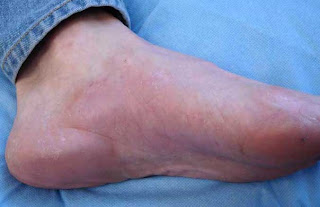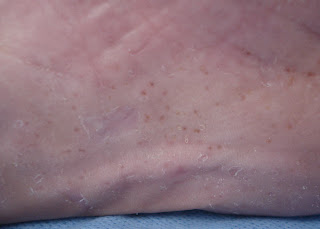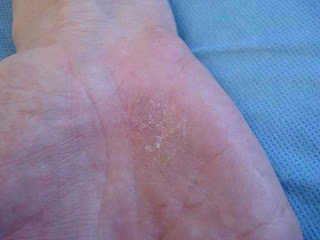Abstract: 65 yo man with recurrent eruption of left buttock
Presented by DJ
ElpernHistory: This 65 yo engineer lives in the United Arab Emirates and was seen while visiting Massachusetts. For the past few years, he has had
pruritic and painful eruptions on his left buttock. He is well and takes no medications by mouth. He was seen by practitioners in Dubai and England. On both occasions, he was treated with oral antibiotics which were not helpful. Over the past few months, he has developed tingling sensations in his left foot and pain in the left leg.
O/E: Photos were taken by patient in the
UAE. This shows confluent pustules on buttock. When seen at my office, only pigment changes and mild scarring were noted.
Clinical Photo(s)
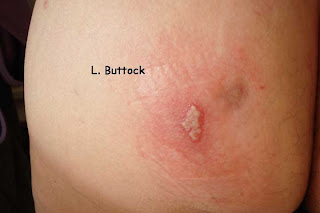
Suggestion of grouped vesicles becoming purulent
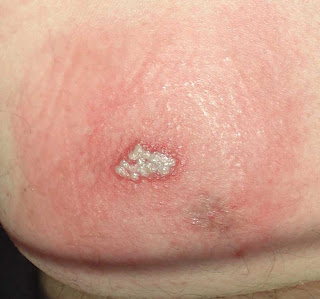
Appearance at time of office visit. Some mild
atrophic scarring and color change is noted.
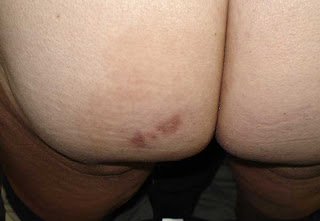
Lab: None
Histopathology: None
Diagnosis: Recurrent Sacral Herpes Simplex.
Comment: The buttocks and lower back are probably the third most common area for
HSV recurrence. Had someone listened to the
patient's history one would have heard "recurrent episodes" which suggests
HSV. Then the history of clear vesicles at the outset makes the diagnosis. Strictly speaking, this is not "genital herpes." After the mouth and genitalia, the buttocks and thighs are probably the most common sites for recurrent
HSV. Sciatic pain has been associated with sacral
HSV (see reference) and often these patients are worked up for renal calculi or sciatica. There may be more constant pain, similar to the post
herpetic neuralgia seen after herpes
zoster.
It would be nice to see the patient with an acute episode so a
Tzanck smear could be done. With his travel history, this may not be practical.
Rx: The acute episodes can be treated with acyclovir or a related drug. When patients have neuralgic pain as this man does, there may be some value in long term suppressive therapy with acyclovir. Dose 400 mg
tid for three or four weeks.
Reason(s) Presented: This is a relatively common disorder, although it is frequently misdiagnosed as bacterial infection or "bite." The key points are recurrent eruptions associated with itching or pain. Grouped vesicles at onset which quickly become purulent. The lesions resolve in one to two weeks. Sacral herpes is commonly associated with neuralgic pain, in my experience.
References: There are few articles on this common disorder. In 1974 RB
Layzer and MA Conant published what remains until today as the most important paper on this subject.
Neuralgia in recurrent herpes simplex.
Arch
Neurol. 1974 Oct;31(4):233-7.
A
PDF of this article is available. Thank you to Barbara Harness, Librarian and
CME Co-Coordinator at Maine General Medical Center facilitated the retrieval of this article.
Basically, it reports on four patients with neuralgic pain associated with
HSV infections. One of these had sciatica as the
prodrome to new episodes. More needs to be written about this entity.






